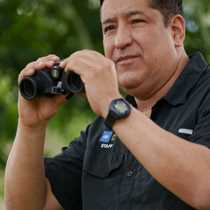Atun Poza & Pacaya River
The Pacaya River Basin is one of the most important components of the Pacaya–Samiria National Reserve. This reserve is the most extensive area of protected floodable forest (varzea) in the Amazon Rain Forest in South America. All over this protected area there are an incredible number of lagoons, lakes, gorges, canals, creeks, and oxbows.
We have had a great week and today was not the exception. Our expedition in the mighty Upper Amazon in Peru continued today with a full day exploring two remote locations, Atun Poza in the morning and the Pacaya River in the afternoon.
Today we experienced firsthand the extraordinary biodiversity that this reserve contains. In the morning while exploring Atun Poza Lake we observed several bird species like flycatchers, hawks, a White-chinned Jacamar, Horned Screamers, Black-capped Donacobius, and many more. In this location we had the thrill of eating our breakfast outdoors aboard the skiffs! This experience is simply amazing, covered with the rain forest we had our early meal served with the green surroundings.
After breakfast we observed a couple of Squirrel and Monk Saki monkey troops. The latter monkey species is a very peculiar one. It is one of the most impressive and attractive primates found in the whole Amazon region. They have a very thick and long dark fur that makes them look bigger than they really are. This long fur is believed to serve as protection from insect bites.
The highlight of the morning was without doubt the finding of a porcupine, which is not a common sighting at all. In fact, it is the first porcupine spotted in way over two years! This peculiar critter was found resting on a lower branch of a tree. It was very well camouflaged. The skills and incredible sight of one of our most talented Delfin II skiff drivers, Primo Puga, let us all of us enjoy this rather uncommon view of this elusive mammal. Porcupines belong to the Erethizontidae family. In this group of mammals all members have stout, sharp spines, prehensile tails, feet with long claws, and inconspicuous ears. Taxonomy is very difficult and some porcupines are poorly known. The correct identification of the animal we saw today is pendant. I will submit the pictures taken today, location and more details to Louis H. Emmons, author of the book Neotropical Rainforest Mammals, a Field Guide (ISBN 0-226-20716-1). Dr. Emmons is a renowned expert in this field and her book has become an essential one for identification of mammals in the Neotropics.
Before lunch one of the chefs from the kitchen galley showed us how to cook a local dish by the name “juane” which is typical in the city Iquitos. Later on during lunch we had the “juanes” we helped to prepare served as a side dish in our delightful lunch.
In the afternoon we had plenty of time to go far beyond the Pacaya River. In a rather rainy afternoon we observed several red Howler Monkey troops. The latter is a hard- to-find species and we were very fortunate for we had extraordinary views of these big New World primates. Late in the afternoon we had time to swim in the middle of a beautiful black water lake with the company of several pink river dolphins and the sounds of the forest.
Late in the evening at around 1815 we arrived back on board with the wonderful feeling and satisfaction of having spent a great day in one of the most intriguing and fascinating ecosystems on Earth—the enigmatic Amazon. Life is good!




